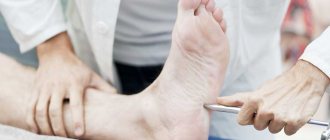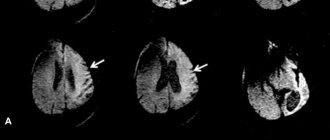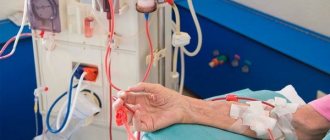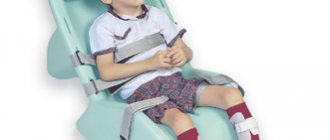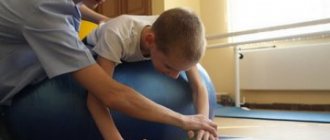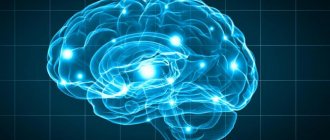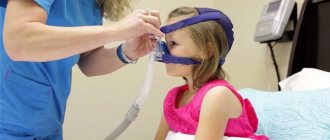Causes of the disease
Birth trauma is a pathological condition characterized by damage to tissues and organs in a newborn during childbirth, which is accompanied by disruption of their functions.
Traumatic injuries become possible when the size of the child does not correspond to the birth canal, during the provision of manual or instrumental assistance or cesarean section. They are also recorded in post-term pregnancy, large fetal mass, malformations, anomalies of presentation, vacuum extraction, narrow maternal pelvis, exostoses and old age of the postpartum woman.
Erb-Duchenne palsy occurs when the spinal cord is damaged at the C5 and C6 level or the superior brachial plexus.
Erb-Duchenne palsy occurs in newborns due to birth trauma, with traction on the arm, head, pelvis or leg of the fetus.
In this case, a rupture, tear, tension in the trunks of the brachial nerve plexus may occur, as well as rupture of the scalene muscles, fascia, and bleeding may occur.
After some time, scar formation occurs around the nerve plexus of the brachial column, causing secondary compression of the plexus, disrupting the conduction of nerves, disrupting blood circulation and the formation of neuromas inside the trunk.
Erb-Duchenne palsy is a disease that occurs in stages, in three stages during which the nerve is restored. The first stage is the acute period of injury (from birth to one month of the child’s life), the second stage is the recovery period (from a month to a year), and the third stage is residual effects (from a year).
Symptoms and course of the disease
The clinical picture of Erb-Duchenne palsy depends on the degree of damage to the nerve fibers. In any case, there is a violation of the innervation of the muscles that raise the shoulder above the horizontal line, the muscles that rotate the shoulder outward. The affected arm is usually extended in all joints and is tightly attached to the child's body. In this case, there is no movement in large joints, there are no tendon reflexes in the affected arm. Sometimes there is a groove between the shoulder and chest as a result of misalignment of the affected arm. In this case, they talk about the “doll hand” symptom.
The most severe cases of upper paralysis involve the higher segments of the cervical spine, the fourth, and sometimes the third. In this case, damage to the phrenic nerve may occur, and breathing disorders are added to the clinical picture, which can in some cases be life-threatening for the newborn.
Treatment of the disease
Diagnosis and treatment of Duchenne-Herb's palsy by orthopedic doctors, neurologists and neurosurgeons. Treatment of paralysis, depending on the severity of the disease, can be surgical or conservative combined with physiotherapeutic procedures.
Conservative treatment of Erb-Duchenne palsy occurs in stages and begins immediately after the birth of the child. Treatment is long-term using various techniques. First of all, the injured limb is immobilized using a removable splint.
The splint is used for a year and is removed only in case of hygiene measures and medical procedures. In severe cases of this disease, the splint is used during the first three years of the child’s life, and is used only at night.
The treatment complex for Erb-Duchenne palsy also includes drug therapy, massage of the injured limb, physiotherapeutic procedures and activities (electrical stimulation of the arm muscles), passive therapeutic exercises, acupuncture and reflexology.
If the child does not noticeably improve the functionality of the affected arm within the first six months, surgical correction is usually indicated.
In the most severe cases of this disease, neurosurgical operations may be prescribed, which are performed on the nerve plexuses, and orthopedic operations on bones, muscles and joints.
In severe untreated cases, they resort to surgical treatment - muscle transplantation or arthrodesis of the shoulder joint; the latter intervention is performed in children no earlier than 10-32 years of age.
When operating on the shoulder joint, surgeons use arthroscopy. This is a new surgical method that allows operations to be performed using optical fiber.
Any surgical intervention is carried out using endoscopic devices, which ensures minimal trauma, is easily tolerated by patients, speeds up the rehabilitation period and significantly reduces the risk of complications. Throughout the rehabilitation period, specialists continue to monitor their patients and help carry out the necessary exercises and procedures.
Etiology of Duchenne-Erb's palsy
As stated earlier, the most common occurrence is upper obstetric paralysis, which develops as a result of birth injury to the fetus. In other age categories, the disease can be caused by damage to the brachial spinal roots located in the area of the 5th and 6th vertebrae. Nerve fibers can be damaged by a strong upper blow, a fall to the side of the arm, a bruise on a static object, by “pulling” the arm to the side, or a penetrating wound into the specified area.
Infantile paralysis is formed when the nerve trunk of the brachial plexus is stretched during turning by the leg, pulling the fetus by the arms, releasing the shoulder from the birth canal, or traction by the pelvis. The described manipulations are necessary in case of incorrect presentation of the child, insufficiently intense labor, a protracted period of delivery, narrow anatomy of the mother’s pelvis, or a large fetus. Often, along with acquired paralysis, there is a combination with torticollis.
The primary manifestations of the injury are inflammation and hematoma in the damaged area. A tear or complete rupture of nerve fibers, vascular walls, and muscles occurs. Over time, acute manifestations disappear, however, at the site of the violation of tissue integrity, scars form, which put pressure on the nerve plexus and the vessels feeding the department.
Diagnosis of the disease
To diagnose Erb-Duchenne palsy, the child is examined by an orthopedist and a neurologist. They also collect anamnesis, which should contain information about the course of pregnancy and childbirth.
To obtain additional information, additional research methods are used: ultrasound examination of the shoulder joint and cervical spine, computer myelography, electromyography, magnetic resonance imaging, vascular Dopplerography of the brain and spinal cord, dynamometry, electroneuromyography, rheovasography and radiography.
Symptoms
The superior bundle of the brachial plexus is the source of nerve fibers for such nerves as the musculocutaneous, axillary and partially radial. With Erb-Duchenne palsy, the function of the muscles controlled by these nerves (deltoid, brachialis, brachioradialis, biceps brachii) is impaired and sensitivity in the area of their innervation is lost. This is accompanied by the following symptoms:
- the inability to actively (that is, independently) bend the arm at the elbow joint (passive flexion is not limited. Passive means “with someone’s help”);
- the inability to raise the arm to a horizontal level forward, or move it to the side, that is, restriction of movements in the shoulder joint. As a result, the hand “hangs” all the time;
- the inability to turn the affected arm outward, as a result of which the arm is brought into the body in such a way that the palm seems to turn away from the body and looks to the side and back;
- the dorsal extension of the hand is weakened, so the palm in a free state is in the position of palmar flexion (due to the prevailing tone of the flexor muscles);
- weakened finger extension;
- sensitivity on the lateral surface of the arm (outer surface of the shoulder and forearm) is impaired;
- the flexion-elbow reflex is not evoked;
- In children, grasping and palm-oral reflexes are also not evoked (in adults they are normally absent);
- muscle tone on the affected limb is reduced;
- the skin feels colder and paler to the touch compared to a healthy limb;
- painful pressure at Erb's point. The point is located above the collarbone outside the attachment point of the sternocleidomastoid (sternocleidomastoid) muscle.
If a newborn baby is held horizontally in the arms, the affected limb will hang down (both in the prone and supine positions).
The severity of the symptoms described above depends on how severely the nerve fibers are damaged. If there is a complete rupture of the bundles, then there will be no movement completely, and if the tear was partial, then the movements will be limited in volume and strength.
In the clinical period of Erb-Duchenne palsy, three stages are distinguished:
- spicy;
- restorative;
- period of residual effects.
The acute stage lasts the first month from the moment of paralysis, the recovery stage lasts up to a year (according to some sources, up to three years), and then comes a period of residual effects that lasts for the rest of life. It is very important to take measures to treat Erb-Duchenne palsy in the acute and recovery stages, since in the period of residual effects radical changes in improving the condition cannot be expected.
By the end of the recovery period and during the period of residual effects, if the patient’s recovery is poor, the affected limb shortens, becomes hypotrophied (loses weight), and in severe cases looks underdeveloped, like a baby’s (and remains that way for life). It is possible to form contractures in the area of the shoulder and elbow joints. In severe cases, a “puppet” groove is formed - a line that limits the transition of the arm to the torso. Muscle atrophy can cause subluxation or even dislocation of the shoulder joint. The scapula on the affected side rotates, its edge seems to move away from the spine. Over time, due to the described changes, curvature of the spinal axis in the cervicothoracic region develops, that is, scoliotic deformity.
Prices
| Disease | Approximate price, $ |
| Prices for diagnosing migraine | 7 060 — 8 260 |
| Prices for diagnosing childhood epilepsy | 3 100 — 4 900 |
| Prices for brain shunting for hydrocephalus | 33 180 |
| Prices for treatment of Parkinson's disease | 58 600 |
| Prices for migraine treatment | 9 680 |
| Prices for the diagnosis of amyotrophic lateral sclerosis | 6 550 |
| Prices for diagnosing epilepsy | 3 520 |
| Prices for rehabilitation after a stroke | 78 300 — 82 170 |
| Prices for treatment of childhood epilepsy | 3 750 — 5 450 |
| Prices for treatment of multiple sclerosis | 4 990 — 17 300 |
| Disease | Approximate price, $ |
| Prices for diagnosing childhood arthritis | 2 000 — 3 000 |
| Prices for diagnosing childhood epilepsy | 3 100 — 4 900 |
| Prices for pediatric neurosurgery | 30 000 |
| Prices for treatment of childhood epilepsy | 3 750 — 5 450 |
| Prices for treatment of umbilical hernia in children | 9 710 |
| Disease | Approximate price, $ |
| Prices for hip replacement | 23 100 |
| Prices for clubfoot treatment | 25 300 |
| Prices for Hallux Valgus treatment | 7 980 |
| Prices for knee joint restoration | 13 580 — 27 710 |
| Prices for scoliosis treatment | 9 190 — 66 910 |
| Prices for knee replacement | 28 200 |
| Prices for treatment of intervertebral hernia | 35 320 — 47 370 |
| Disease | Approximate price, $ |
| Prices for pediatric neurosurgery | 30 000 |
| Prices for craniotomy | 43 490 — 44 090 |
Treatment of Duchenne-Erb's palsy
In the acute period of the disease, doctors resort to complete restriction of movements in the affected limb. To do this, an immobilization splint is applied. Parallel restorative manipulations are:
- visiting a massage therapist;
- exercise therapy classes;
- physiotherapeutic measures.
At this stage, pharmacological painkillers, anti-inflammatory drugs, medicinal substances that improve blood circulation and metabolic processes can be prescribed.
If therapeutic measures are poorly effective, the patient is referred for consultation to a neurosurgeon. The specialist evaluates the feasibility of surgical intervention. In childhood, instrumental correction is best performed at 6-7 months of life. Therefore, after three months of conservative treatment, you need to think about possible surgery. During neurosurgical manipulations, corrective plastic surgery of the nerve trunk is performed. Only microsurgical techniques are used.
With prolonged treatment in the stage of residual effects, it is no longer possible to restore the full functionality of the limb. Orthopedic interventions aimed at restoring the anatomical position of the hand can improve the condition. Some motor abilities that were previously lost may also be restored.
Complications and prognosis
Obstetric Duchenne-Erb palsy, even with proper therapy and rehabilitation, can still have certain consequences, which are characterized by the following symptoms:
- Over time, children may develop shortening and dystrophy of the hand .
- In addition, underdevelopment of the scapula , which manifests itself in its reduced size and asymmetrical location.
- Due to the injury and, as a consequence, damage to the nerve fibers of the brachial plexus, symptoms of scoliosis , which mainly affects the cervical and thoracic spine.
- Despite the fact that in more than half of cases positive results can be achieved, some children develop a decrease in muscle strength in a relatively healthy arm .
- Also in practice, there have been cases where severe damage to the brachial plexus was accompanied by a slight narrowing of the eye on the side of the damaged limb . However, this consequence passed quickly enough with proper and timely therapy.
Duchenne-Erb's palsy is a very serious injury, and in order to avoid serious complications, it is extremely important to begin therapy immediately after the birth of the child.
Thanks to this, over time, the function of the damaged hand is restored, and the child can live a full life. Prevention of this birth injury consists in proper management of pregnancy and childbirth, adequate choice of method of delivery, thanks to which the risk of injury to the child will be minimized.
Misha Permyakov needs a series of operations
The boy is nine months old. He has obstetric Duchenne-Erb palsy. In other words, he received paralysis during an unsuccessful birth. His right arm cannot move. He needs a series of complex surgeries to essentially rewire the nerves in his right arm. VALERY PANYUSHKIN talks about Misha to pediatric hematologist Professor ALEXEY MASCHAN.
“You know what Duchenne-Herb palsy is, right?”
- Of course, this is a classic obstetric complication that occurs during childbirth because a nerve is pinched.
“According to Misha’s mother, premature labor began in her thirty-fifth week of pregnancy after an unsuccessful examination. That is, according to her, the doctor screwed something up. Or does the woman blame the doctor in vain? And I want to ask, how should we treat medical errors? What should the patient think and do? What should a doctor who makes a mistake think and do?
“I don’t know the details, but I don’t think that some careless examination could have caused premature birth.” As a patient, mom treats the situation correctly. Because the child suffered, and, naturally, the mother blames the doctors. But what actually happened there cannot be said without a detailed study of the issue. The point here is different. Let's even assume that the doctor is at fault. Even if the doctor is at fault, then a damaged nerve cannot be corrected by admitting a medical error. The doctor's guilt should be established so that the doctor who made the mistake pays for the treatment, right? In America, if the doctor is at fault if he made a good faith mistake, then he has good faith error insurance and his insurance will cover the patient's further treatment. In France, the clinic pays for the mistakes of its doctors, and the clinic is insured against medical errors. We do not have medical malpractice insurance. A doctor or a hospital can be sentenced in court, but in practice this almost never happens. The second question is: why does the boy need money for the operation? This is an operation in Russia. The boy is a citizen of Russia. What then? Is the operation not covered by the quota? That's the same thing - quotas. I would hang the people who came up with quotas on a branch and on a lantern...
— Sounds good coming from a humanist doctor...
- ... on the bitch and on the lantern, write it like that. Because quotas are fascism. This is a mechanism for limiting patients' access to medical care. Quotas have turned medicine into commerce. I hate it.
“The boy spent some time in intensive care. Then he was diagnosed with Duchenne-Herb palsy and was told that his right arm would just hang there and that nothing could be done about it. Mom herself found on the Internet what procedures are used for children with Duchenne-Erb palsy, and she herself paid for massage, gymnastics and physical therapy. What is this? Self-medication?
- This is a new option for self-medication, yes. The Internet is a great information revolutionary. Mom chose a very correct algorithm. If they said that it is impossible to help, you need to go on the Internet and look for people who can help, look for doctors in Russia, Germany, Israel or anywhere. The problem is that on the Internet, for every one useful source of information, there are ten that are harmful or extort money. Firstly, advice may appear on the Internet that has nothing to do with how to treat. Secondly, subtle medical information may emerge that parents themselves cannot apply. People should get information from the Internet, but never treat themselves using the Internet. Duchenne-Erb's palsy is another simple case. Just imagine what will happen if people begin to receive treatment for leukemia over the Internet.
- Mom took Misha to Moscow - to the Institute of Pediatrics. They said that conservative treatment must be continued and that there are no radical treatments for this paralysis. Misha’s mother herself found a Yaroslavl clinic on the Internet, where they began to operate on the boy. In my opinion, patients should be informed differently about where, how and what kind of help they can get. How, tell me, should patient information be organized?
— Information must be arranged. The doctor must provide the patient with all the information if he knows it. The problem is that our doctors themselves are poorly informed. There are much more doctors in the West, and it is much easier for them to refer patients for consultations with colleagues. We have a kind of professional pride. Misunderstood. A doctor often considers himself the best specialist in his field. And we, indeed, have excellent doctors, but for the most part our doctors do not go to international conferences, do not receive foreign journals and do not read any language other than Russian. It is possible to establish a process of continuous education for doctors, but it is very difficult. This was largely done by pharmaceutical companies. But the Antimonopoly Service did not like their activity. The Antimonopoly Service saw elements of corruption in the cooperation between doctors and pharmaceutical companies. And I couldn’t find anything better than simply banning this cooperation. The new health care law devotes an entire chapter to what pharmaceutical companies should not do. Nowadays, no one is seriously engaged in the continuing education of doctors.
— As you might guess, the boy’s family is not rich. Dad is a driver. Mom doesn't work. And the boy Misha, at least until he was one year old, was denied registration for disability. How can this be?
- Very simple. Anything can happen in our country. Incurable patients confirm their disability with us every year. This is a bureaucratic system, not a human one. And before, they thought little about people, but now they have stopped thinking about them altogether. How this boy did not receive a disability due to some formal chicanery criteria, I can imagine very well. It’s just that no one thought about the boy, they thought about saving the budget.
RUB 540,000 is not enough to save nine-month-old Misha Permyakov.
Deputy chief physician of the Solovyov Hospital Yuri Filimendikov (Yaroslavl) says: “Misha has severe damage to the brachial plexus, his right arm hangs with a whip. If left untreated, Misha will not be able to care for himself. We plan microsurgical surgical treatment in several stages, the goal is to recreate the anatomical integrity of the nerves through reconstruction and plastic surgery of the nerve trunks. First, microsurgical reconstruction of the brachial plexus will be performed, then the scar blocking the growth of nerve fibers will be excised, and autonervous inserts will be sewn in instead. All treatment will last at least a year. Usually, if the first operation is performed before 12 months after the birth of the child, the range of motion is fully restored.”
Yaroslavl Hospital named after. Solovyova billed the Permyakovs for 540,000 rubles. Misha's family is unable to pay for it.
Dear friends! If you decide to save Misha Permyakov, then don’t let the cost of salvation bother you. Any donation from you will be gratefully accepted. Money can be transferred to the charitable foundation “Help” (founders: the publishing house “Kommersant” and Lev Ambinder). All the necessary details are available at the Russian Relief Fund. You can also use our electronic payment system
by making a donation using a credit card or electronic cash, including from abroad (details at rusfond.ru). Thank you.
Expert group of the Russian Relief Fund
Forecast
How will Erb-Duchenne's palsy end: full recovery or disability? This depends on many factors:
- on the severity of damage to nerve fibers;
- from the timeliness and correctness of treatment;
- from scrupulously following all the recommendations of the attending physician (and therefore the patience of the patient and his parents).
With partial damage to the upper bundle of the brachial plexus, even 100% recovery is possible (according to statistics, up to 20% of patients with partial damage have such a chance). With a complete breakaway, unfortunately, the chances are much less. However, timely surgical treatment increases their percentage.
Thus, Erb-Duchenne palsy is a disease that can be overcome. Its main symptoms in the form of limited movement in the shoulder and elbow joints can be minimized if you seek medical help in a timely manner and do not let the situation take its course.
Causes of Duchenne-Erb paresis
Doctors and midwives sometimes have to perform manipulations to help the baby be born alive. We are talking about situations when unforeseen complications occur during childbirth, and it is too late to perform a caesarean section. This may be an incorrect presentation of the fetus, its large size, pathologies in the mother’s birth canal, or prolonged labor that is dangerous for the mother and child.
During emergency obstetrics, sometimes you have to pull the baby by the hand, free the shoulder, hip. At this moment we are talking about saving lives. With a sharp movement of the head and forceps, the connection between the nerve processes and the trunk may be disrupted. The brachial plexus of nerve fibers cannot withstand the tension, and nerve tissue ruptures. This leads to obstruction or poor conduction of impulses along the nerve pathways. Part of the body does not obey the brain and its commands, because impulses do not reach muscles and skin. Insensitivity of the skin develops and the inability to bend the elbow independently. Subsequently, such a person experiences atrophy of the muscles of the entire arm and curvature of the spine.
There are cases of the development of Duchenne-Erb's palsy due to trauma to the spine and neck received during childbirth.
The same mechanism of disease development operates at any age if the disease develops after injury.
Paralysis can be caused by:
- falling on a bent elbow or outstretched arm;
- a strong tug on the hand, including an attempt to stop someone from falling;
- hematomas or scars after injuries with compression of nerve tissue;
- knife or gunshot wounds affecting nerves;
- a strong blow to the shoulder from above;
- sometimes - during a car accident, compression of the shoulder by a car belt;
- various neck injuries.
If the superior bundle of the brachial nerve plexus is damaged, the innervation of several muscles associated with it is disrupted. These are the brachioradialis, biceps, deltoid muscles, and several smaller muscles. When the nerve process is completely severed, independent movements and sensitivity disappear completely. In case of a tear, depending on the degree of damage, the ability to move the arm may be preserved to some extent.
There is no complete blocking of the joints. It is impossible to bend the elbow only by one’s own effort, but if, for example, parents bend the child’s arm, this can be done without difficulty.
In rare cases, paralysis becomes a consequence of intoxication of the body caused by poisoning, infection, or severe chronic disease. These diseases include tuberculosis, diabetes, rheumatism, malaria, typhoid, and severe influenza. Poisoning from lead, arsenic, chromium, carbon monoxide and other substances can cause paralysis.
